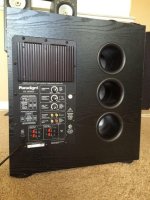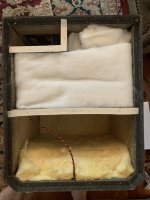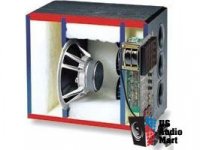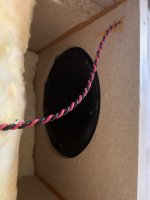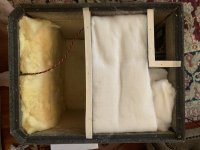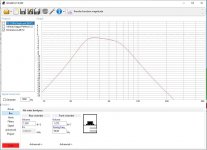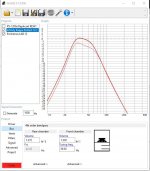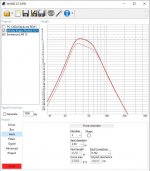I have a bandpass-designed Paradigm PS-1200a subwoofer and as a thought exercise I would like to use two or more software packages to see what 12" drivers might work well with this beast of an enclosure. Unless I am missing something trying to use WinISD, the program wants me to start a project with a known driver and ends with an enclosure recommendation. I am trying to do the reverse...start with a known bandpass enclosure and end with driver parameter recommendations based on the existing and other amplifiers. Can anyone recommend a software package (free is always best) that will do this?
Thanks - Rick
Thanks - Rick
I have carefully measured all dimensions of the bandpass enclosure and I have removed the original 12" driver for the Paradigm PS-1200a (Part # B156WFPS01200A 0299) and will refoam it. I could not find parameters for it online so I will contact Paradigm to see if they have them.
But, I am still curious what driver parameters would be recommended by reputable software packages based on my entering of the existing ~35-year-old enclosure and amplifier parameters.
But, I am still curious what driver parameters would be recommended by reputable software packages based on my entering of the existing ~35-year-old enclosure and amplifier parameters.
4th order Bandpass has a sealed rear chamber and ported front chamber.
6th order Bandpass has ported rear and front chamber.
Within reason your looking for a driver that mechanically works well
in a sealed box for a 4th order.
Usual rule of thumb is Efficiency Bandwidth Product or EBP for sealed drivers
You take the drivers free air resonance (Fs) and divide by total electrical quality (Qes)
Fs/Qes = EBP
EBP of 50 is considered good for sealed, but there is plenty of sealed drivers
which have a EBP of around 50 to 75
once you start getting up to 80 or higher
its likely more suited for ported.
Or in a nutshell you could use something 80 or higher
but its likely going to be much larger box to get a good response.
To reverse engineer in WinIsd you need to find a driver candidate
and enter it in to WinIsd.
Open the driver in a bandpass Box type.
And then enter the measured specs you have from the already built enclosure.
as mentioned it depends on your box 4th order has sealed rear. 6th order
will have ported rear and front.
Be sure you use internal volume measurements
and also remember the driver removes or displaces volume
and the port also removes volume.
If your pre built enclosure has slot ports WinIsd wont calculate
your measurements well at all.
If you have round ports, WinIsd would be able to calculate
End correction around .732 for non flare .850 for flared
If you do have slot ports sharing 3 walls you need a program
which you can actually change End correction.
like VirtuixCad since end correction would be very high at 2.227
for 3 shared walls.
6th order bandpass is more friendly to drivers that can use ported enclosures
but if the overall enclosure is small. Sealed drivers still work well or be
more manageable as far as box size.
6th order Bandpass has ported rear and front chamber.
Within reason your looking for a driver that mechanically works well
in a sealed box for a 4th order.
Usual rule of thumb is Efficiency Bandwidth Product or EBP for sealed drivers
You take the drivers free air resonance (Fs) and divide by total electrical quality (Qes)
Fs/Qes = EBP
EBP of 50 is considered good for sealed, but there is plenty of sealed drivers
which have a EBP of around 50 to 75
once you start getting up to 80 or higher
its likely more suited for ported.
Or in a nutshell you could use something 80 or higher
but its likely going to be much larger box to get a good response.
To reverse engineer in WinIsd you need to find a driver candidate
and enter it in to WinIsd.
Open the driver in a bandpass Box type.
And then enter the measured specs you have from the already built enclosure.
as mentioned it depends on your box 4th order has sealed rear. 6th order
will have ported rear and front.
Be sure you use internal volume measurements
and also remember the driver removes or displaces volume
and the port also removes volume.
If your pre built enclosure has slot ports WinIsd wont calculate
your measurements well at all.
If you have round ports, WinIsd would be able to calculate
End correction around .732 for non flare .850 for flared
If you do have slot ports sharing 3 walls you need a program
which you can actually change End correction.
like VirtuixCad since end correction would be very high at 2.227
for 3 shared walls.
6th order bandpass is more friendly to drivers that can use ported enclosures
but if the overall enclosure is small. Sealed drivers still work well or be
more manageable as far as box size.
Last edited:
Thank you very much for the informative reply. I will do some measuring/calculating and see what information I can get directly from Paradigm. If you don't mind, please check this thread for more data. I would love to hear more of your thoughts. Attached are some pictures of the opened 4th order Bandpass enclosure and rearview where the 3 ports exit. The ports and driver are in the white polyfill section and the driver fires into the section with yellow fiberglass. The small section at the upper left contains the amp and power supply.4th order Bandpass has a sealed rear chamber and ported front chamber.
6th order Bandpass has ported rear and front chamber.
Within reason your looking for a driver that mechanically works well
in a sealed box for a 4th order.
Usual rule of thumb is Efficiency Bandwidth Product or EBP for sealed drivers
You take the drivers free air resonance (Fs) and divide by total electrical quality (Qes)
Fs/Qes = EBP
EBP of 50 is considered good for sealed, but there is plenty of sealed drivers
which have a EBP of around 50 to 75
once you start getting up to 80 or higher
its likely more suited for ported.
Or in a nutshell you could use something 80 or higher
but its likely going to be much larger box to get a good response.
To reverse engineer in WinIsd you need to find a driver candidate
and enter it in to WinIsd.
Open the driver in a bandpass Box type.
And then enter the measured specs you have from the already built enclosure.
as mentioned it depends on your box 4th order has sealed rear. 6th order
will have ported rear and front.
Be sure you use internal volume measurements
and also remember the driver removes or displaces volume
and the port also removes volume.
If your pre built enclosure has slot ports WinIsd wont calculate
your measurements well at all.
If you have round ports, WinIsd would be able to calculate
End correction around .732 for non flare .850 for flared
If you do have slot ports sharing 3 walls you need a program
which you can actually change End correction.
like VirtuixCad since end correction would be very high at 2.227
for 3 shared walls.
6th order bandpass is more friendly to drivers that can use ported enclosures
but if the overall enclosure is small. Sealed drivers still work well or be
more manageable as far as box size.
Attachments
OK, parallel 6th order (BP6P), so once we have the dims of everything, should be able figure them out by 'trial n' error' in Hornresp or WinISD, especially if there's frequency/impedance plots.
looks like they isolated the amplifier section so there is no air leaks.
unless I am missing something it looks like 4th order?
front chamber looks a little large, but after subtracting the amplifier section, ports , and driver
the volume will make more sense.
pretty cool design
unless I am missing something it looks like 4th order?
front chamber looks a little large, but after subtracting the amplifier section, ports , and driver
the volume will make more sense.
pretty cool design
Note the three vent tubes with the top one running through the white damping to the low pass filter chamber.
To clarify, I think it is a 4th-order Bandpass design. The three 3.5" diameter ports all extend into the enclosure 5". None extend into the low pass filter rear chamber. Please see the additional pictures below. The enclosure internals are seen by removing the bottom of the cabinet and I rotated that image so that directionally aligns more closely with the other images.
Attachments
I still have not heard back from the folks at Paradigm. In the meantime, I have calculated the volume of my ~35 year old Paradigm PA-1200a, 4th order bandpass subwoofer. The built-in amplifier puts out 130 watts RMS. WinISD modeling of someone's suggested Eminence LAB 12 driver is seen belowOK, thanks! Late night insomnia did me in again. 🙁
The rear, ported area = 1.338 cu. ft. (I accounted for the .128 cu ft displacement of the 12" driver)
The front sealed area = 1.272 cu. ft.
IMHO the Eminence LAB 12 is not a great driver for this subwoofer. Your thoughts?
Attachments
Last edited:
Vent diameter = 3.5", length= 5"
I also note that WinISD describes the "vent" as being in the "Front Chamber". (See second image below). As a result, I have changed the entry of my dimensions to match WinISD.
I have now entered the ported box dimensions into what WinISD calls the "Front Chamber" and I entered the sealed box dimensions into what WinISD calls the "Rear Chamber". Is this now correct for using WinISD?
The graph for the Infinity kappa perfect 12.1 driver looks better than the Eminence, yes?
I also note that WinISD describes the "vent" as being in the "Front Chamber". (See second image below). As a result, I have changed the entry of my dimensions to match WinISD.
I have now entered the ported box dimensions into what WinISD calls the "Front Chamber" and I entered the sealed box dimensions into what WinISD calls the "Rear Chamber". Is this now correct for using WinISD?
The graph for the Infinity kappa perfect 12.1 driver looks better than the Eminence, yes?
Attachments
The box tuning frequency of 39 hz is just a guess pending any information I receive from Paradigm. I sent their technical support team an email 2 days ago but have not received a reply. I may try calling them today.
Haven't used WinISD since I posted this using an earlier version, so no clue and ATM only 'know' that one PS1200a measured flat to 24 Hz, making yours off a bit if truly trying to find as close as practical OEM driver specs.
Hmm, the HR BP4 Wizard calcs a ~65 Hz Fb = ~45 Hz F3, which seems reasonable to me IME, so lacking any more info this implies there's some fixed or at least adjusted, amp EQ and/or corner loading in that 24 Hz measurement.
Some of the information in that post seems to be incorrect. In the post he says, "the amp is rated 250 watts RMS continuous and 750 watts peak." I believe the amp in the PS-1220a (early version) had 130 watts RMS. Paradigm increased the amp output in later versions of the PS-1200.Hmm, the HR BP4 Wizard calcs a ~65 Hz Fb = ~45 Hz F3, which seems reasonable to me IME, so lacking any more info this implies there's some fixed or at least adjusted, amp EQ and/or corner loading in that 24 Hz measurement.
Perhaps the "flat down to 24 Hz" is also in error?
The Data in the post is someone trying to sell it , so who knows?
Keep in mind we also have 3 ports which displace a little volume
not much though. would be a little over 2 liters or 2.34 liters
or .081 cu ft
1.338 cu ft - .081 = 1.257
Basically in a simplified manner
the front/rear chamber are equal in volume basically around 1.25/1.27 cu ft or pretty much 36 liters
3.5" x 5" port or 8.89 cm x 12.7 cm
cross sectional area of single port is 62.2 cm2
total cross sectional area 186.6 cm2
WinIsd and Vituix Cad both give a Fb of around 87.6 Hz
with .850 end correction ( dual flare)
so
36 liters x 36 liters 87 Hz Fb
unless of course these are 3" ports? and you included the flare
then Fb would be around 77 Hz
for the most part this is a pretty straight forward 40 Hz
sub designed for drivers good for around 150 to 200 watts
-3 dB response is going to be around 40 Hz
with many different drivers.
Keep in mind we also have 3 ports which displace a little volume
not much though. would be a little over 2 liters or 2.34 liters
or .081 cu ft
1.338 cu ft - .081 = 1.257
Basically in a simplified manner
the front/rear chamber are equal in volume basically around 1.25/1.27 cu ft or pretty much 36 liters
3.5" x 5" port or 8.89 cm x 12.7 cm
cross sectional area of single port is 62.2 cm2
total cross sectional area 186.6 cm2
WinIsd and Vituix Cad both give a Fb of around 87.6 Hz
with .850 end correction ( dual flare)
so
36 liters x 36 liters 87 Hz Fb
unless of course these are 3" ports? and you included the flare
then Fb would be around 77 Hz
for the most part this is a pretty straight forward 40 Hz
sub designed for drivers good for around 150 to 200 watts
-3 dB response is going to be around 40 Hz
with many different drivers.
Last edited:
My numbers are negligibly different, but I did misread the Wizard's displacement minima due to needing stronger reading glasses for HR's plots, so ~75 Hz Fb in lieu of ~65 Hz with the 3.5" dia. with whatever end correction HR uses for a summed ~6.06"/15.4 cm dia. (assume basic 0.732), so no clue why the discrepancy.
Re the Infinity Kappa; it's a 'one note wonder' @ ~83 Hz ditto the Lab12c.
Changing the Lab12c's specs to a 34 Hz Fs, 0.39 Qts + 0.5 ohm (Rg) for wiring losses yields a ~50 - 110 Hz F3 flat response, so at least a starting point if we can get the various program's discrepancies ironed out.
Re the Infinity Kappa; it's a 'one note wonder' @ ~83 Hz ditto the Lab12c.
Changing the Lab12c's specs to a 34 Hz Fs, 0.39 Qts + 0.5 ohm (Rg) for wiring losses yields a ~50 - 110 Hz F3 flat response, so at least a starting point if we can get the various program's discrepancies ironed out.
Attachments
Last edited:
Hi Rick,I have a bandpass-designed Paradigm PS-1200a subwoofer and as a thought exercise I would like to use two or more software packages to see what 12" drivers might work well with this beast of an enclosure. Unless I am missing something trying to use WinISD, the program wants me to start a project with a known driver and ends with an enclosure recommendation. I am trying to do the reverse...start with a known bandpass enclosure and end with driver parameter recommendations based on the existing and other amplifiers. Can anyone recommend a software package (free is always best) that will do this?
Thanks - Rick
yes you can use Speakerboxlite to do exactly that- put in parameters for your existing/pre-made box and the software will choose a shortlist of drivers for you. You select the brand or size,and the software gives you a shortlist.
i like the App better than the web interface. Both are free.
Well worth the donation or subscription service
WinISD is great but really it is from the 20th century
Thank you GM, White Dragon and tktran !
Per tktan's suggestion, I think I will make a donation to use Speakerboxlite because I don't think I am using WinISD correctly.
By the way, I totally miscalculated how to measure and adjust for the area of three, 3.5", 5" long ports (Using online calculators, I came up with a total area of .83507 cu ft which = 23.646 liters??) And for what it is worth, some adjustments could be made to the ports quite easily if there was a benefit.
Per tktan's suggestion, I think I will make a donation to use Speakerboxlite because I don't think I am using WinISD correctly.
By the way, I totally miscalculated how to measure and adjust for the area of three, 3.5", 5" long ports (Using online calculators, I came up with a total area of .83507 cu ft which = 23.646 liters??) And for what it is worth, some adjustments could be made to the ports quite easily if there was a benefit.
- Home
- Design & Build
- Software Tools
- Use design software to select subwoofer driver for existing bandpass enclosure?
